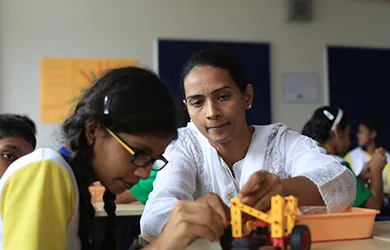- Our Story
- Our Impact
-
Our Projects
Residential
Commercial
- Careers
Empowering Gifted Minds: The Pathway to India's Future Growth
By Lodha
February 25, 2025
As India charts its course toward becoming a developed economy by 2047, the nation must focus on a broad spectrum of priorities. These include women’s empowerment, education, healthcare, skill enhancement, advancements in science and technology, infrastructure development, employment generation, agricultural growth and the expansion of manufacturing and industrial production. As global economies adapt to the challenges of the 21st century, India must ensure its growth strategy aligns with the rapidly changing landscape of technological innovation, sustainability, and equitable development. This multi-pronged approach will determine how effectively the nation can transition from being a major emerging economy to a global leader. Among these priorities, science and technology will serve as critical drivers of progress.
India has successfully evolved from an agrarian economy to a service-driven one. However, achieving transformative and exponential growth in the coming decades will demand leadership in the next wave of scientific and technological innovation. To achieve this, India must transition from being a participant in global advancements to becoming a pioneer. India’s future leadership will depend on its ability to excel in emerging fields such as renewable energy, biotechnology, space exploration and advanced manufacturing. These domains hold the key to creating a competitive edge in global markets while addressing critical challenges like climate change and resource scarcity. Countries like the United States and China are prime examples, having positioned themselves as hubs of innovation by heavily investing in artificial intelligence and other cutting-edge technologies. Their success is underpinned by the strength of their human capital—fostered through national programs that identify and support gifted individuals from an early age. These initiatives extend beyond academics to include holistic development, ensuring their brightest minds lead the way in innovation.
In contrast, India faces significant challenges, such as the persistent brain drain issue, depriving the country of its brightest talent. While platforms like national Olympiads and scholarship programs (such as KVPY and NTSE) aim to recognise gifted students, they often stop at financial rewards or acknowledgement. For instance, China’s ‘Thousand Talents Plan’ and the U.S.’s National Science Foundation scholarships are exemplary models that combine academic rigour with industrial mentorship. These programmes not only attract top global talent but also retain them through well-structured career pathways and research funding, creating ecosystems where innovation thrives. However, truly unlocking the potential of gifted individuals requires much more than this. These students are not merely academically talented; they demonstrate creativity, divergent thinking, and the ability to tackle complex challenges with determination—qualities that are indispensable in a rapidly evolving world. This lack of holistic nurturing is also reflected in global rankings, with India filing significantly fewer patents and producing fewer globally recognised innovations compared to its counterparts. This gap highlights the untapped potential of India's brightest minds, who often leave for opportunities abroad or struggle to find an environment conducive to innovation within the country. Their contributions have the potential to drive breakthroughs across technology, science, and the arts, provided they are equipped with the right opportunities and resources.
To nurture such talent, India needs to build a comprehensive ecosystem that goes beyond conventional curriculums. Policy-level initiatives should prioritise the systematic identification and development of gifted students. Educational frameworks must actively encourage research and cultivate the natural curiosity of young minds, which is vital for innovation in science and technology. Policy changes must include the establishment of talent development centres, personalised learning plans tailored to gifted students and incubation hubs in schools to encourage entrepreneurship and innovation from an early age. Additionally, collaboration with global institutions can offer gifted students exposure to international best practices. Furthermore, socio- emotional development is critical. Skills like collaboration, leadership, communication, stress management, and adaptability should be integral to their training, ensuring they grow into well-rounded individuals capable of thriving in any environment.
The private sector has an equally vital role to play. By fostering robust public-private partnerships, challenges related to infrastructure and funding in research and development can be effectively addressed. For example, partnerships like those between Tesla and U.S. research universities have shown how industry collaborations can fast-track innovation. In India, such models can be replicated by involving leading technology firms and research institutions to co-develop programs that combine academic learning with practical industry experience. Such collaboration would enable the creation of specialised programs, mentorship opportunities, and advanced facilities tailored to the needs of gifted students.
By combining targeted policies, an enriching curriculum, socio-emotional support, and public-private cooperation, India can create a nurturing environment for its most gifted minds. With its demographic dividend—boasting one of the youngest populations globally—India stands at a unique advantage. By harnessing the potential of its gifted minds, the country can not only address domestic challenges but also position itself as a global hub for innovation, contributing solutions that influence the future of humanity. This approach will not only prevent the loss of talent but also position the nation as a global leader in innovation and creativity, paving the way for unprecedented growth and securing its place at the forefront of the next technological and economic revolution.
You may also like



 Enquire
Enquire
 Call
Call
 chat
chat
 Search
Search





